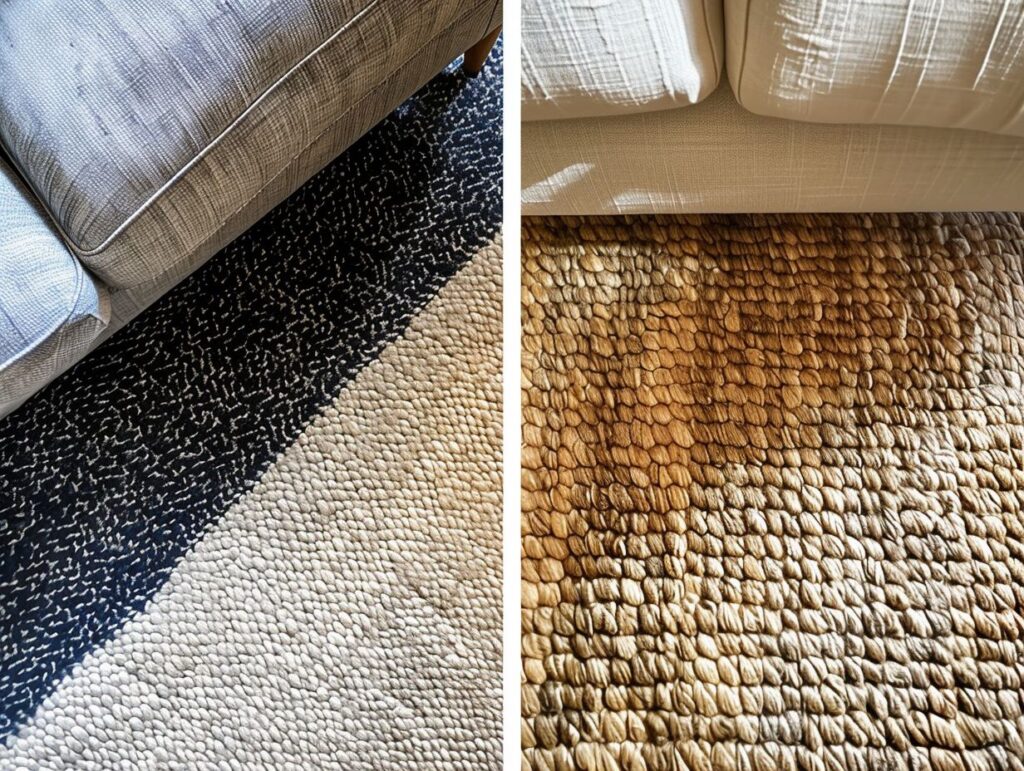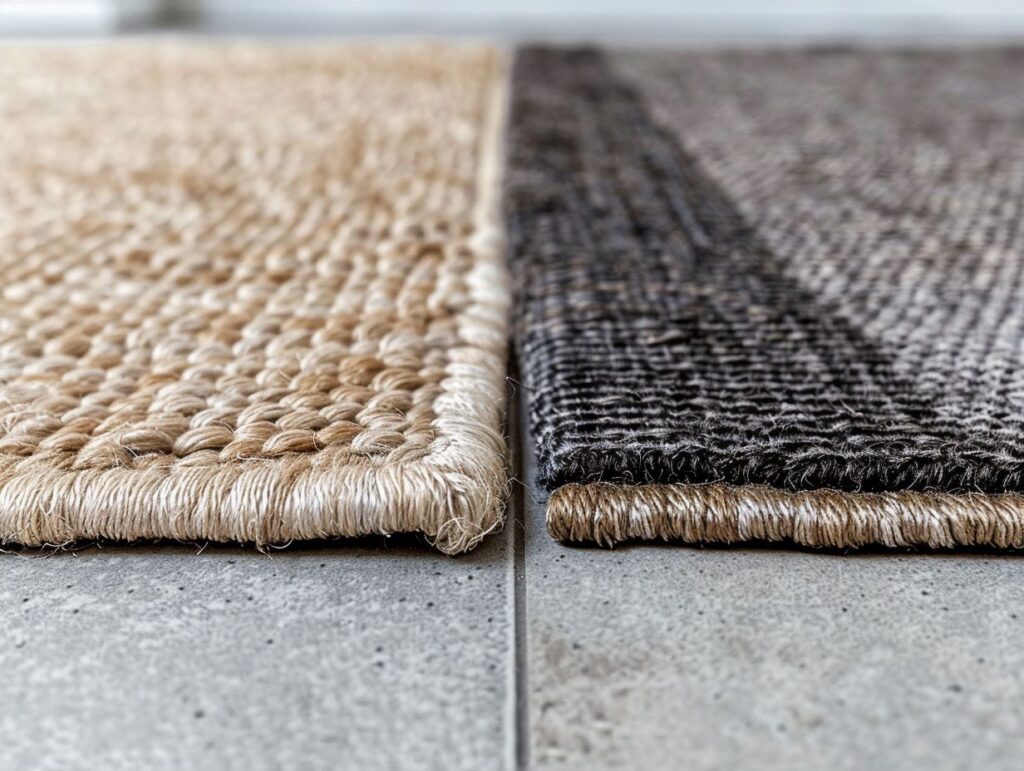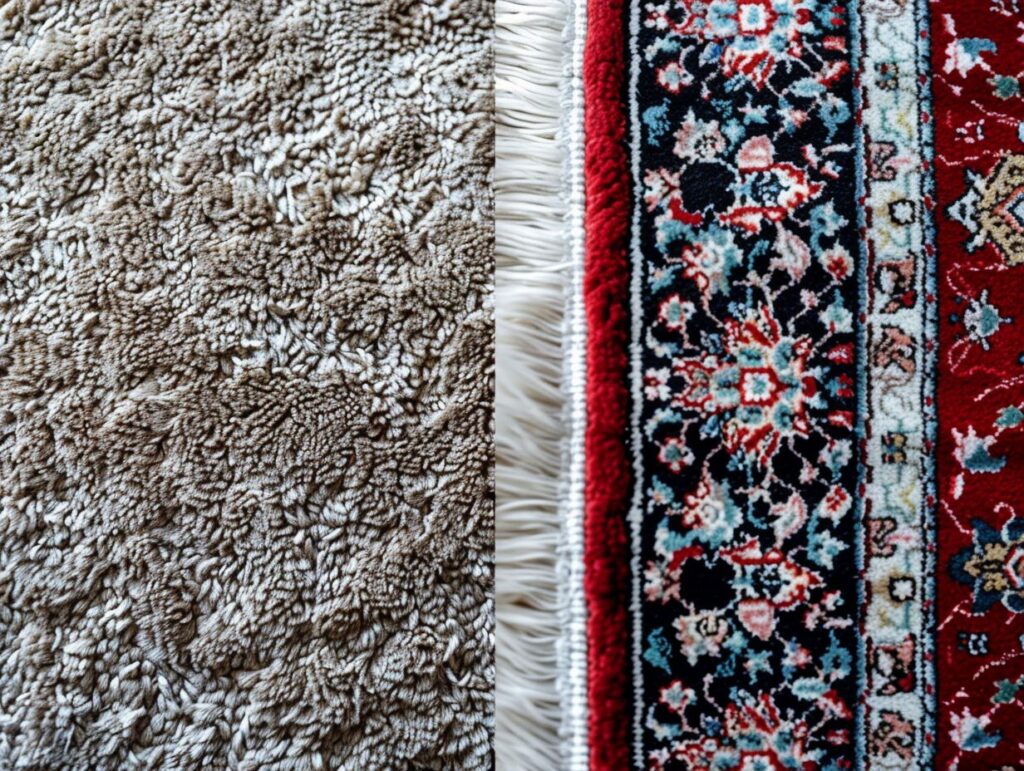If you’re in the market for a new carpet but feeling torn between wool and synthetic materials, we’ve got your back! Let’s break down the pros and cons of each option to help you make the right choice.
Whether you’re all about the durability and comfort of wool carpets or looking for the affordability and variety of synthetic ones, we’ll cover all the bases. So, we’ve got you covered whether you’re into eco-friendliness, stain resistance, or sticking to a budget.
Explanation of Materials and Differences
Understanding the key materials used in carpets, such as natural fibres like wool and man-made fibres like synthetics. Each type has unique properties that can affect durability, maintenance, and eco-friendliness, as well as significant differences in cost and overall performance.
Wool carpets are all about that luxe, soft feel. They are naturally tough and resistant to crushing and staining. On the other hand, synthetic carpets, made from materials like nylon or polyester, are super resilient and less likely to fade in sunlight.
Regarding maintenance, wool carpets need some extra TLC and often require professional cleaning to keep them looking top-notch. On the other hand, synthetic carpets are a breeze to clean and more resistant to stains.
And hey, if you’re big on environmental friendliness, wool carpets are your jam. They’re biodegradable and renewable, making them a sustainable choice for eco-conscious consumers like yourself.

Pros of Wool Carpets
Wool carpets are your go-to choice if you’re looking for a carpet that goes above and beyond. Made from natural fibres, they bring many perks to the table. Think top-notch durability, ultimate comfort, and an eco-friendly vibe. They’re also super soft, great at holding the heat, and fire-resistant. Plus, they’re hypoallergenic and biodegradable. Wool carpets are the whole package for anyone who wants it all.
Durability and Comfort
Wool carpets are durable and incredibly comfortable. They offer a soft, resilient surface that handles everyday wear and tear.
Compared to synthetic fibres like nylon or polyester, wool stands out for its exceptional softness and natural bounce-back ability. Walking on a wool carpet is like stepping onto a cloud, bringing a touch of luxury and warmth to any space.
Wool carpets are terrific for high-traffic areas because they hold shape and withstand heavy foot traffic. Unlike synthetic options that feel stiff or fake, wool carpets have a natural elasticity that keeps them fresh and inviting throughout the years.
Environmental Benefits
When you choose wool carpets, you’re getting a soft and cosy flooring option that positively impacts the environment. These carpets are made from natural fibres that are hypoallergenic and biodegradable, creating a more eco-friendly space for you.
Wool carpets are a clever choice if you want to reduce your environmental footprint. Their natural fibres mean they require fewer synthetic materials to make, reducing the use of harmful chemicals in production. Plus, wool is renewable – sheep can be sheared annually, ensuring a constant supply of this eco-friendly material. And if you have allergies, wool carpets are perfect for you because they’re hypoallergenic, promoting a healthier indoor environment.
When your wool carpets finally reach the end of their lifespan, they biodegrade naturally. This means less waste in landfills and a step towards a circular economy. So, not only are you getting a beautiful and sustainable flooring option, but you’re also doing your part for the planet.

Cons of Wool Carpets
You have to weigh the pros and cons of wool carpets. Sure, they have their perks, but they also have some downsides. Think of higher costs, more maintenance work, and problems with shedding, stain resistance, and soaking up moisture.
Cost and Maintenance
When considering wool carpets, one of the main things to consider is the higher cost and the need for regular upkeep to deal with things like shedding.
If you go for wool carpets, you might notice that they’re pricier upfront than synthetic options, but the long-term perks often make it worth it.
Keeping up with maintenance is vital to keeping your wool carpets looking good and lasting long. Try vacuuming at least once a week to reduce shedding and prevent dirt from getting deep into the fibres. Getting a professional deep clean every 12-18 months is also a good idea to get rid of embedded dirt and keep your carpet feeling fresh. These maintenance tasks come with added costs, but wool carpets’ durability and plush feel make them a smart investment.

Pros of Synthetic Carpets
When shopping for carpets, consider synthetic options made from man-made fibres. They’re a hit with many people because they’re budget-friendly and come in many choices. Plus, they’re great at resisting stains, offer many colours to choose from, and have other perks like water-resistant and fade-resistant. That all adds to a pet-friendly, anti-static carpet and is a solid choice for many homes.
Affordability and Variety
When considering carpet options, synthetic carpets have a lot going for them. They’re super budget-friendly and come in a vast range of styles and colours, all thanks to the magic of man-made fibres.
Using synthetic fibres for carpets saves you money and gives you many options for patterns and textures. Whether you’re into that plush, cosy vibe or need something rugged and stain-resistant, synthetic carpets have you covered. Plus, they can mimic the look and feel of fancy natural materials like wool or silk without breaking the bank. That’s why budget-savvy folks like you often choose synthetic carpets – they give you the best bang for your buck!
Stain Resistance
Synthetic carpets are a smart choice for your bustling home because they are highly resistant to stains, water, and fades.
These carpets are made with special fibres that naturally repel spills and stains, keeping them from seeping deep into the fibres. With their water resistance, liquids bead up on the surface so you can clean up easily without any lasting damage. Plus, their fade-resistant quality ensures these carpets keep their vibrant colours, even in high-traffic areas soaked in sunlight, keeping them looking great for longer.
Cons of Synthetic Carpets
Even though synthetic carpets have a lot of perks, you might run into a few downsides along the way. You could be looking at some health and environmental worries, dealing with static electricity troubles, and wondering how durable they’ll be in the long run.
Potential Health and Environmental Concerns
One of the primary drawbacks of synthetic carpets is the potential health and environmental concerns associated with their production and use, including issues like static electricity.
The manufacturing process of synthetic carpets often involves using harmful chemicals and toxins, which can harm your health and the environment. Studies have shown that these chemicals can off-gas over time, leading to indoor air pollution and respiratory issues.
Disposing of synthetic carpets contributes to landfill waste and can take centuries to decompose, further impacting our ecosystems. The prevalence of static electricity in synthetic carpets causes annoyance and can also attract dust and allergens, exacerbating indoor air quality problems.
Factors to Consider When Choosing Between Wool and Synthetic Carpets
Consider your budget, lifestyle, and personal preferences when deciding between wool and synthetic carpets. Also, consider each type’s durability, maintenance, cost, appearance, texture, installation, and environmental impact.
Budget, Lifestyle, and Personal Preferences
When deciding between wool and synthetic carpets, consider your budget, lifestyle, personal preferences, and factors like durability, maintenance, cost, appearance, texture, installation, and environmental impact.
If you’re leaning towards wool carpets, you’ll appreciate their natural softness, luxurious feel, durability, and eco-friendliness. However, they might need a bit more TLC and come with a higher price tag.
On the flip side, synthetic carpets offer many colours, patterns, and textures, are usually more budget-friendly, and are a breeze to clean. However, they might not be as environmentally conscious.
Considering the foot traffic your space sees, the upkeep you’re willing to put in, and your overall design style, you can make a smart decision that fits your needs.